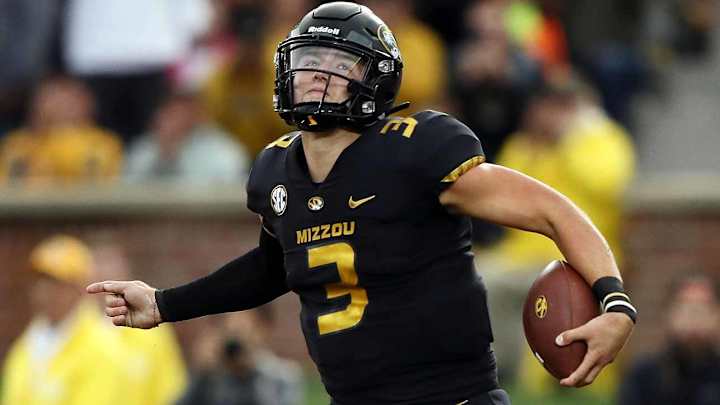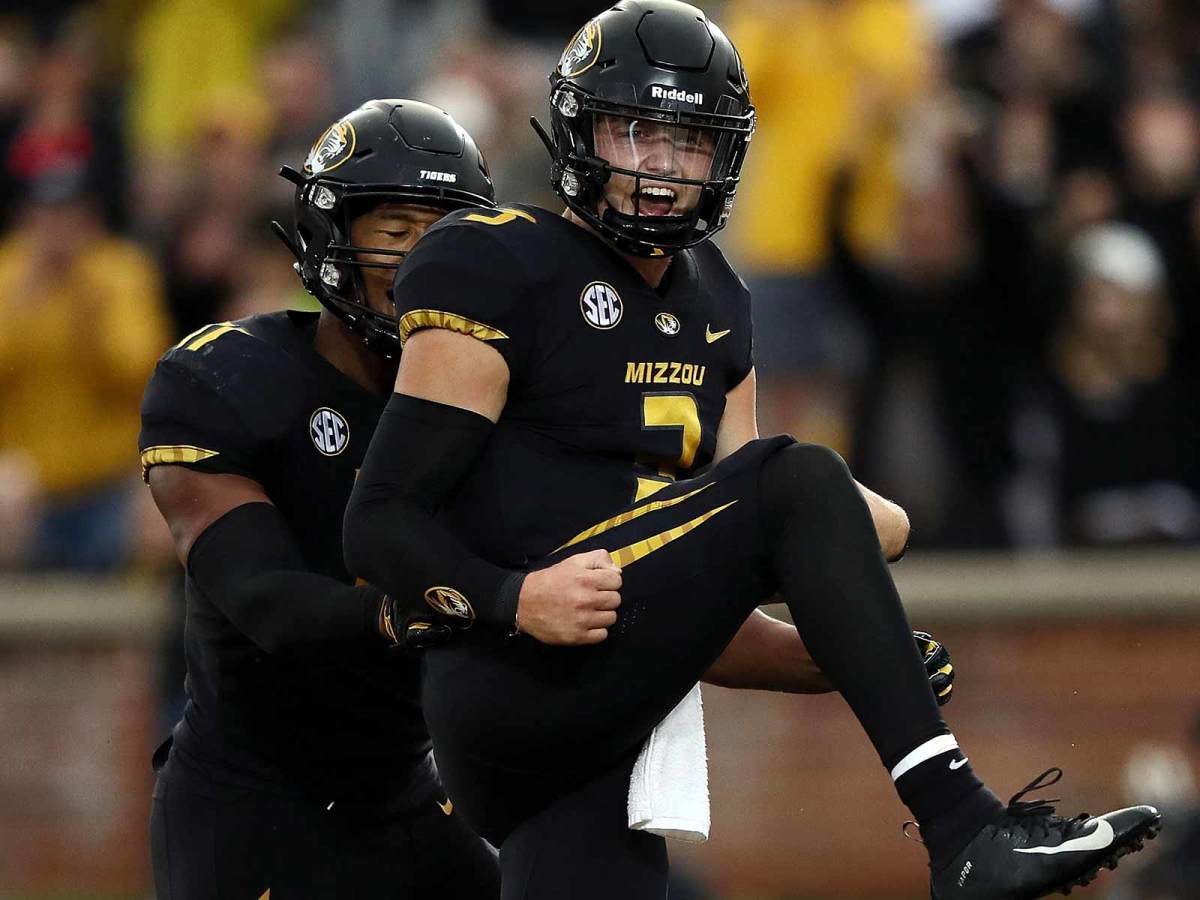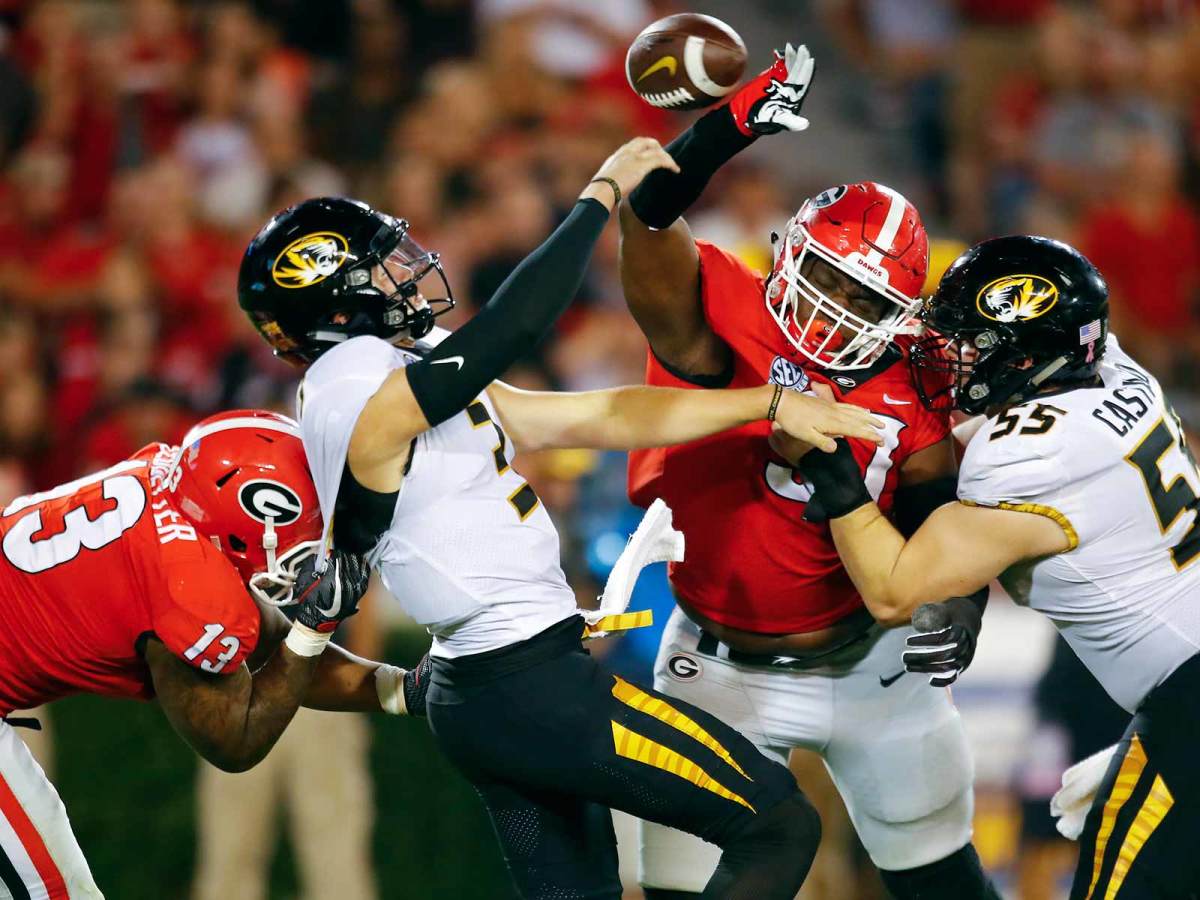Drew Lock Is Better Off for His Roller-Coaster Missouri Career

Drew Lock grew up a fan of the team he now leads. He was good enough to play elsewhere, and as a teenager he allowed his mind to occasionally wander to other suitors, but he always came back to his original choice. It was always going to be Missouri for the 6'4" kid with a special arm and pocket presence that’s shaping up to be nearly as impressive.
We’ve all read the “Highly-touted recruit stays home” story before, just not as often in Missouri, where only seven times since 2000 has the state’s top prospect committed to the Tigers. Lock, a Columbia native who played his high school ball at Lee’s Summit outside of Kansas City, is the most recent example.
The quarterback who was Missouri’s No. 1 recruit in 2015 is the son of a former Tigers offensive tackle. Andy Lock played during some of the program’s leanest years, smack in the middle of the 13-season stretch in which Missouri did not make a bowl game and averaged three wins a year. Destined to be a fan of a historically horrendous program, Drew Lock was at least born at exactly the right moment: 1996, the year Missouri joined the brand-new Big 12. He became a football fan as Chase Daniel led the Tigers to their only No. 1 ranking for a fleeting week in 2007, saw Jeremy Maclin’s theatrics at receiver and a steady stream of defensive linemen trot off to the NFL. He watched Gary Pinkel take the Tigers from a perennial doormat to back-to-back SEC East crowns en route to becoming the winningest coach in Missouri history.
And so it wouldn’t have been too far-fetched for Lock to have imagined this season, in which he is the senior quarterback of (barring disaster) a bowl-bound SEC team, with an outside shot at the Heisman Trophy, gaining momentum as a potential top pick in next spring’s NFL draft. That is, it wouldn’t have been too far-fetched to predict this four years ago. In 2015, Lock’s good timing ran out.
Drew Lock Is Poised to Rise Up NFL Draft Boards
A fatalist (and there are plenty among the fan base) might say some sort of nightmare season was bound to happen, and sure enough, Lock arrived on campus in time for just about Missouri football’s worst moment this century. As a freshman, the quarterback saw Pinkel, the coach he’d dreamed of playing for, retire due to a cancer diagnosis, days after his team agreed to a boycott of football activities and nearly forfeited a game. Mizzou football became the sport’s most polarizing subject: a crusade for good, a team out of control a coach who cared about something more, a coach who let his players derail a season.
Off the field, there was no gray area. On the field, at the point in early November when everything turned upside-down, Lock was 1–4 as a starter in a season he probably shouldn’t have started at all, after his predecessor Maty Mauk had been suspended on his way to a permanent dismissal. In the years to come, the quarterback would go on to bounce through three offensive coordinators. Missouri missed bowl games in each of his first two years and got off to a 1–5 start to his junior season—and yet here he is, having used an epic turnaround in 2017 to stake his claim to the title of the SEC’s best quarterback, now 3–0 as a senior heading into a home game against Georgia that doubles as the biggest stage of his career.
“I think scars are cool,” Justin Hoover, Lock’s private instructor for the past six years, says. “I think he likes them. This is a kid that hadn’t at that point had to deal with a lot of adversity ... and then all the sudden, it got flipped upside-down. To me, that’s what’s so rad about his journey. He’s been through some stuff, and people don’t give him enough credit for how he’s handled it all.”

Lock’s years at Lee’s Summit High School in Missouri were, as Hoover notes, about as devoid of adversity as they come. The biggest decision the teenager had to make was between football and basketball, the two sports he was talented enough at to have played at the next level. A four-star recruit, Lock arrived at Missouri in the summer of 2015—still claiming he wanted to hoop in college but fully committed to quarterbacking—on the heels of the Tigers’ 11–3 campaign in ’14. Having played in (and lost) the SEC championship game for the second straight year the past fall, the Tigers looked like a team on the rise. Entering its fourth season in the conference, Missouri had found its legs quickly, albeit in the weaker SEC East, and even if remained on a tier below the top of the West, it appeared to belong.
The young quarterback’s trajectory could have been as breezy as his high school career had unfolded. Incumbent Maty Mauk had struggled with off-field issues, but going into 2015, it seemed like Lock would have at least his freshman year to settle in as a backup. Wrong. Mauk was suspended in late September and then yanked for the rest of the season in one of Pinkel’s final moves as Missouri’s head coach in November.
“It wasn’t easy when I first got here,” Lock says. “That season was a whirlwind. You come in thinking you have a coach that's going to stay with you for at least the four years you have. I grew up with Coach Pinkel being the man. And then for [the protest and his retirement] to happen right before we go on the road to go to K.C., to play in Arrowhead for my first time [a 20–16 win over BYU]—that was a lot.”
Lock’s freshman season ended with the Tigers missing a bowl game for just the second time since 2005. They won just one SEC contest, and in 2016, things didn’t get much better: Under new coach and former defensive coordinator Barry Odom, Missouri finished 4–8. Entrenched as the starter, Lock threw for 3,399 yards and 23 touchdowns, but Missouri was a team without an identity. Known for so many years as “D Line Zou,” a nod to the seven defensive linemen and linebackers the program saw picked in the first two rounds of the NFL draft from 2009 to ’15, Missouri chose to embrace that moniker with the decision to promote Odom, but Odom’s teams struggled defensively while Lock and the offense quietly put up points. The Tigers seemed lost, but the messy opening game of the ’17 season should have given them a hint of their path to success. Against Missouri State, an FCS squad that would go on to finish 3–8, Missouri put up 72 points—and allowed 43. These Tigers were not going to compete with heavyweights on the strength of their defense, and as they proceeded to lose five games in a row, they looked like a team that might not compete at all—a bowl berth was out of the question, and a conference win seemed like a tough ask.
But in that fifth loss, on the road at No. 4 Georgia, Lock threw for 253 yards, four touchdowns and an interception against a top-10 defense. The quarterback had thrown for just six touchdowns in his past four games, but that day, something shifted. Lock and the Tigers were about to go on a run that would ultimately define the quarterback’s college career.

That trip to Athens almost a year ago was Lock’s last game against a ranked foe, and on Saturday, the same Bulldogs—now ranked No. 2—roll into Columbia in an afternoon battle of SEC unbeatens. To expect Missouri to pull off the upset would be foolish, but the game will be a fascinating test for the retooled Tigers, who sprinted to a 7–6 finish last year with help from a closing slate of lesser opponents. “It’s a great opportunity for us,” Lock said Tuesday on The Paul Finebaum Show. “It’s going to be an awesome game. Getting UGA in here and this being a big-time SEC game, it’s something that Columbia needs and something that the university needs.”
It’s also something Lock needs. In 2017, he threw an SEC-record 44 touchdown passes and finished behind only three Power 5 quarterbacks in passing yards: Baker Mayfield, Mason Rudolph and Sam Darnold. Still, due to the Tigers’ Jekyll-and-Hyde season, Lock didn’t figure into the Heisman race, and he labored over his decision to stay in school. “I knew that I would be able to go out there and throw it as well, if not maybe a little bit better than most of the top six guys that everyone was saying would go in the first six,” Lock explains. “But what was really holding me back was being able to speak the [language] of football at a level that I needed to.”
After playing in the SEC’s worst offense under the direction of coordinator Josh Henson in 2015, Lock had spent the past two seasons in Josh Heupel’s fast-paced, Air-Raid-style attack. When Heupel left to become UCF’s head coach in December, Missouri found itself at a crossroads—as did Lock. No matter his success, he knew he’d made his name playing in an offense that has never translated well to the NFL and worried about being able to talk football at the level he needed to in the interview room.
In looking to replace Heupel, Missouri found itself in a unique position. It was wise to do whatever it took to keep Lock for his senior season, but knowing the quarterback’s hesitancy, the conventional route didn’t make sense. Plenty of players in Lock’s position would have preferred a measure of continuity, leery to learn a new system for one final year of college when they could move to the pros and get paid to do the same thing. But Missouri’s quarterback was the exception—and when the Tigers’ brass went the unorthodox route, bringing in Cowboys receivers coach Derek Dooley and his pro-style scheme, it didn’t take long for Lock to make his decision. “Within our first conversation,” Lock says of Dooley, “I knew I was going to learn the pieces [that I needed] to be a first-round draft pick.”
In the spring, Lock was floored by how quickly he picked up language he’d never heard in Heupel’s offense. Dooley’s playbook is massive by comparison—which was bizarrely comforting. “[Last year] it was a little bit more of a guessing game for me,” Lock says. “I had to read the receivers a lot, rather than knowing exactly what they were doing. [Now,] there's a ton more, but I know exactly what everyone’s doing, how to make myself protected, where everyone’s going to be—to the point where I feel way more relaxed out there.”
“I don’t necessarily have to hope for something to happen. I can make it happen.”

Through three games in Dooley’s offense, the Tigers have shown flashes of their former selves, and their comfort with playing quickly adds a wrinkle to Dooley’s pro-style scheme. Lock has still thrown with the velocity and accuracy—especially on deep balls—that long-ago caught the eyes of NFL scouts, but he has also shown poise in the pocket, working through his progressions rather than staying locked in on one receiver. “[Defenses know] this offense is such a good down-the-field throwing team,” Hoover says. “[Now] you’ll see this offense take a check-down, hit a tight end on a choice route. As teams try to keep things in front of them, I’m seeing Drew mature and say, I’m not going to take a shot. I’m going to take what they give me. … I think he’s a better situational football player than he was a year ago.”
Against Purdue in Week 3, Lock got the ball back with 3:28 remaining and the score tied at 37. Facing second down at Missouri’s 25-yard line, Lock had to scramble and spun out to his right to avoid a sack, then found running back Tyler Badie, who took a short pass for a 20-yard gain. The play kept Missouri’s game-winning drive alive—and showcased as-yet-seen progress from Lock. “A year ago, he doesn’t get to that guy,” Hoover says. “I just don’t think that happens.”
Lock’s 1,062 yards this season put him on pace to exceed his yardage of a year ago, though some of the SEC’s stoutest defenses still loom. He’s averaging 9.4 yards per attempt (barely down from last year’s 9.5), has 11 touchdown passes and, most notably, has completed 69% of his throws, up significantly from 57.8% in 2017. The stat deflation that Dooley’s arrival portended hasn’t yet become reality, but even if Lock doesn’t break all his own records of a year ago, he won’t be concerned. “Football-savvy people will realize [what’s happening],” the quarterback says. “They’re going to see the plays we run. They’re going to see the type of throws we have in our offense, the way we work the offense, from our running to our pass game. They’re going to see us control games.”
Lock jokes that he imagines the biggest pushback will come from fans on Twitter if his seasonlong touchdown total dips. But the quarterback learned as a freshman to delete the social media app in-season, so he can only drum up that digital antagonism in his imagination. For instance: This fall, Missouri designed a bobblehead for season-ticket holders, which depicts the quarterback ready to pass. When the first mock-up of the figurine was released, Lock had two complaints: Bobblehead Drew had brown eyes (Actual Drew’s eyes are blue) and was holding the football “like he was holding a dessert tray.” In the final version, the grip was altered to look more like that of a future first-round pick. The eyes? They’re still brown, but Lock is unconcerned. In fact, when it comes to the bobblehead, he’s most interested in how fans might turn to destroying it: “I can’t wait until I get the first video of someone throwing it off their balcony if I throw a pick or something.”
It should come as no surprise, then, that Lock posed for a selfie with the Purdue fan who posted up in the front row of Ross-Ade Stadium last Saturday with a sign reading “Mizzou Still Sucks.” He’s grinning ear-to-ear, eating it up: the sign, the win, the mangled bobbleheads that exist, more than likely, nowhere but in the quarterback’s imagination.
Here is Drew Lock's selfie with the #Purdue student who made the "Mizzou Still Sucks" sign. The fan wrote a Reddit post detailing his account of the fun interaction: https://t.co/UcTTMD4E1L pic.twitter.com/SK7jj5acRV
— Peter Baugh (@Peter_Baugh) September 18, 2018
“The fun part for me the past couple of years,” Lee’s Summit football coach Eric Thomas says, “is starting to see that little bit of swagger come back, that little bit of edge. I don’t think he’d be what he is now had he not had to go through that. If he’d walked in his freshman year and everything had been sunshine and roses ... he wouldn’t be as good as he is.”
